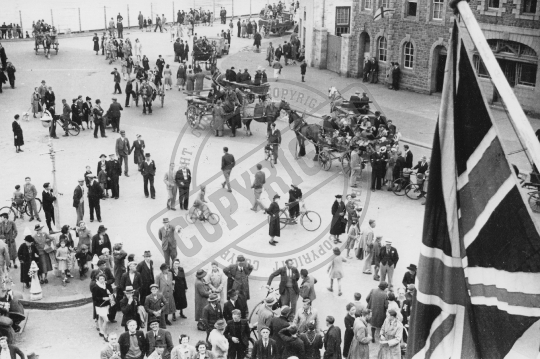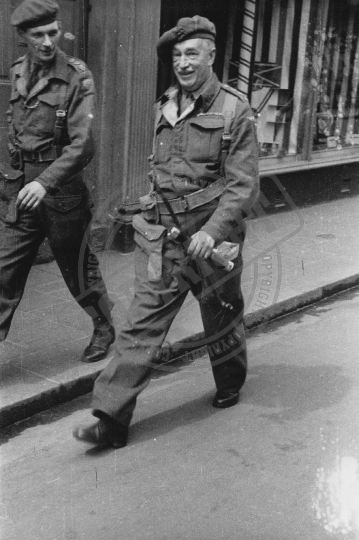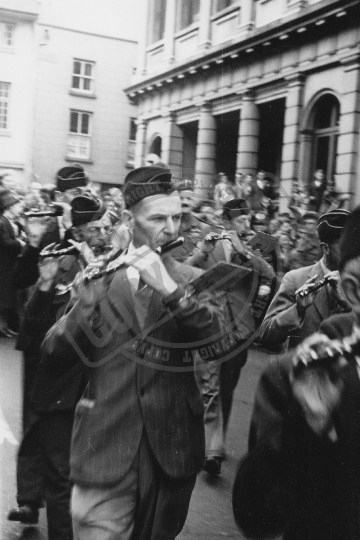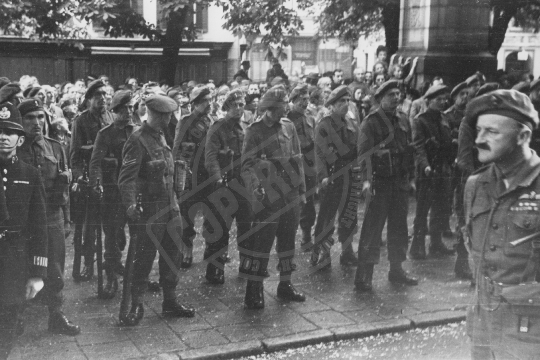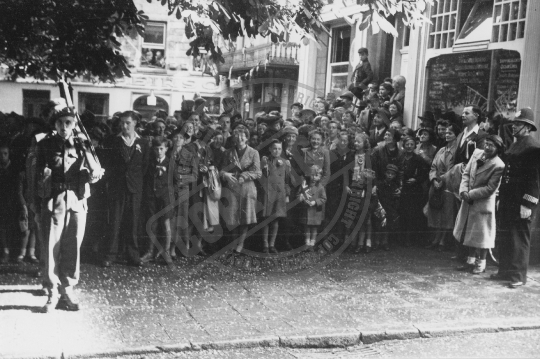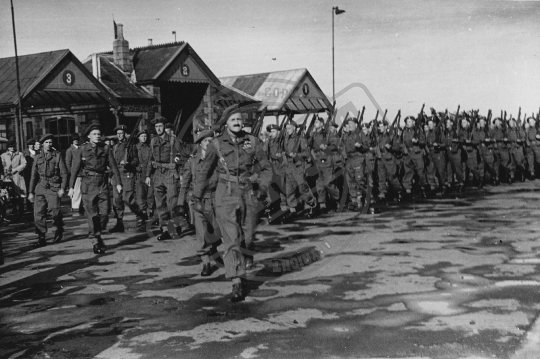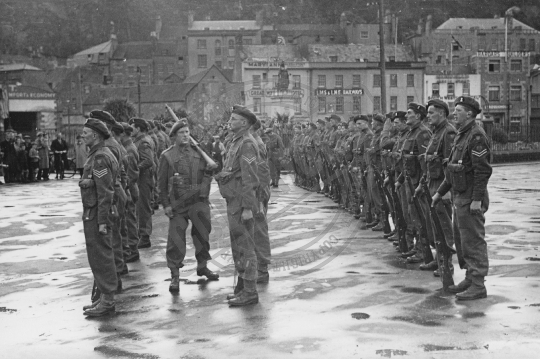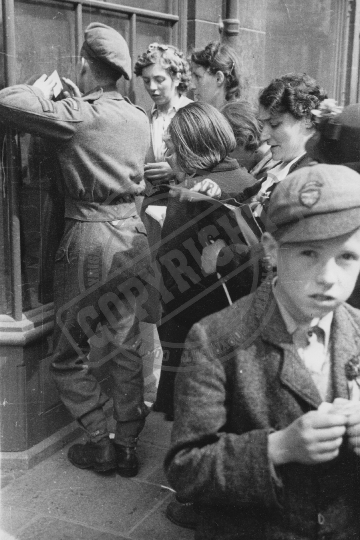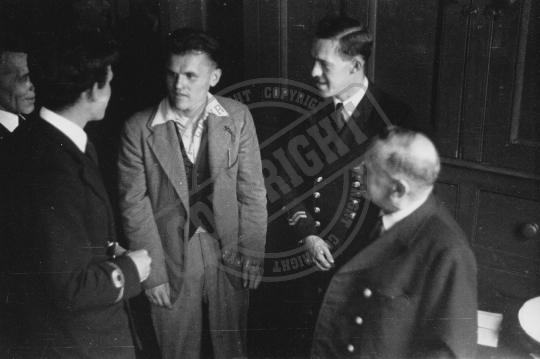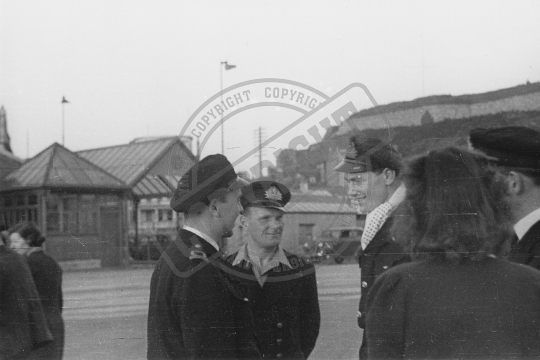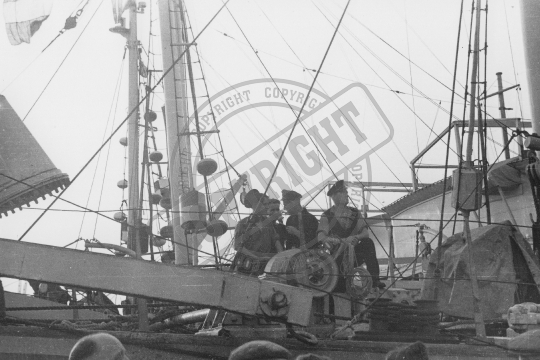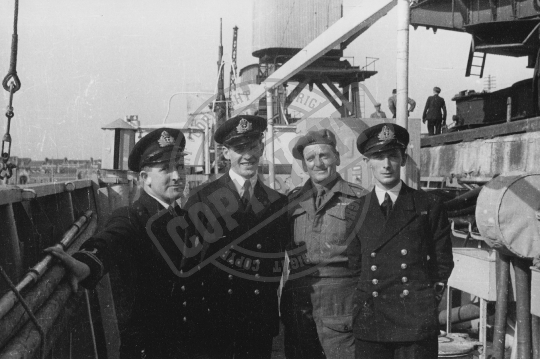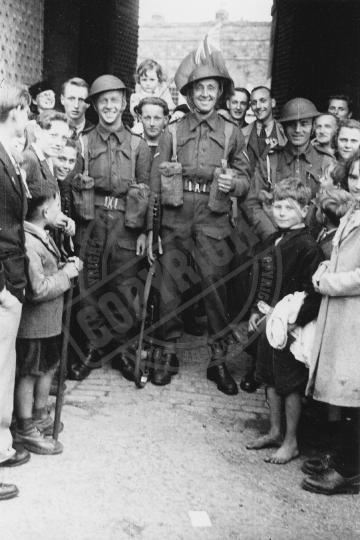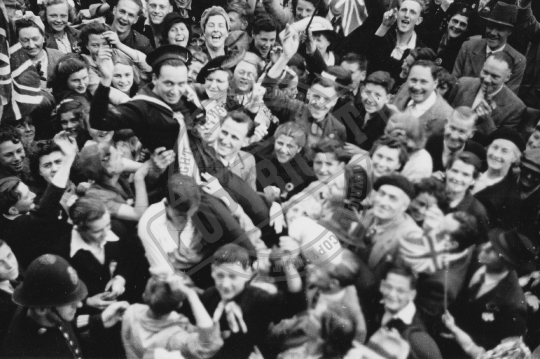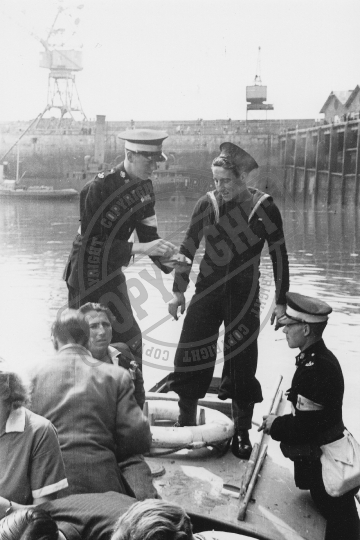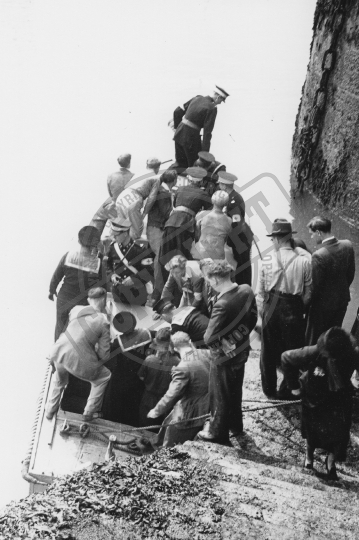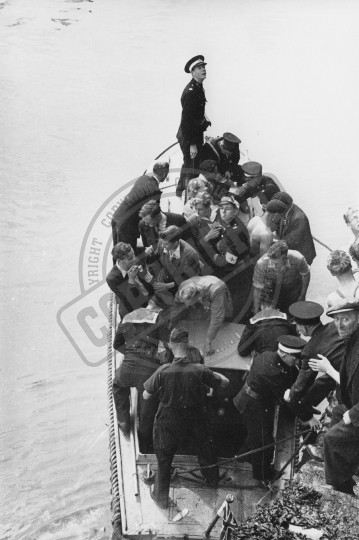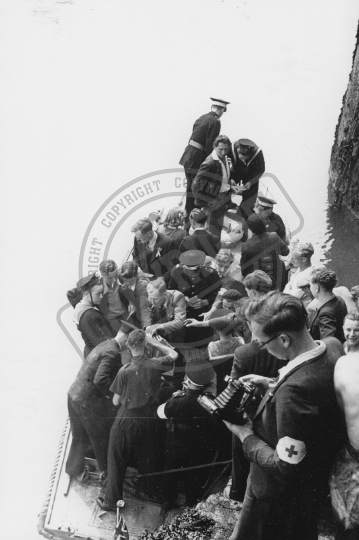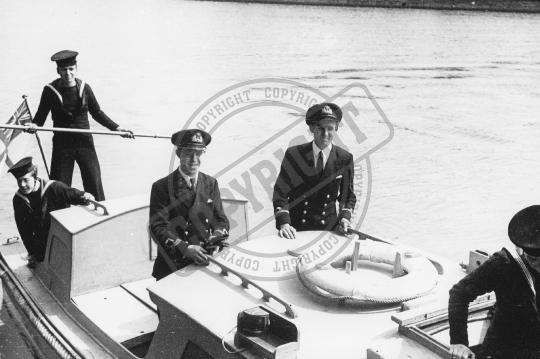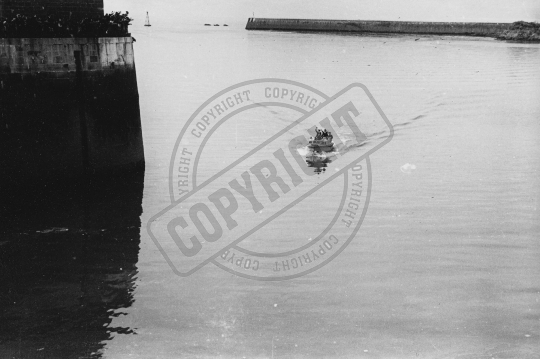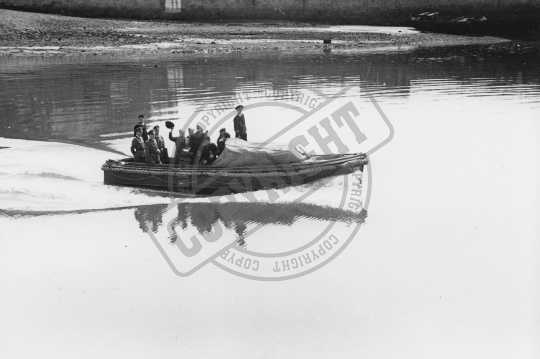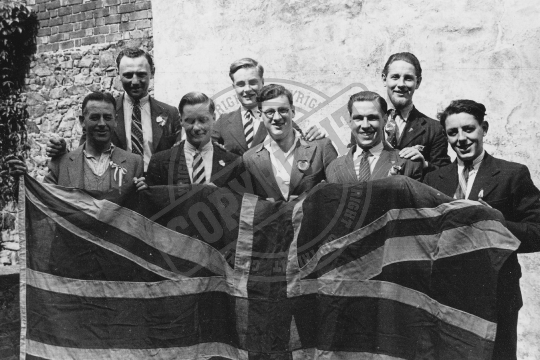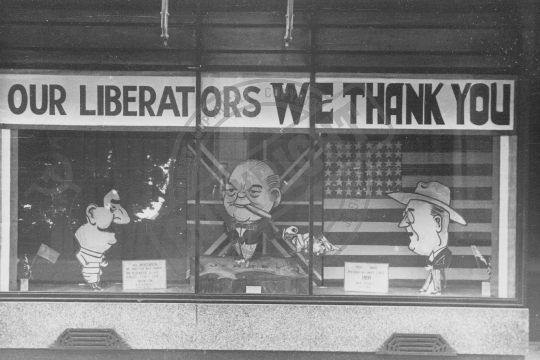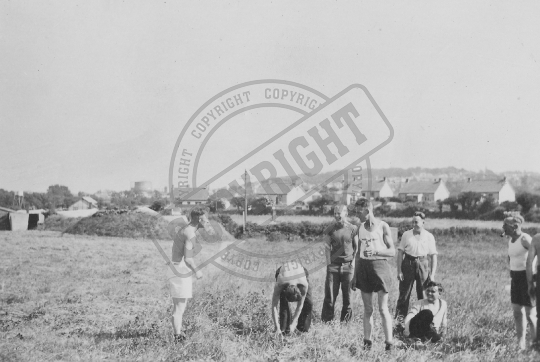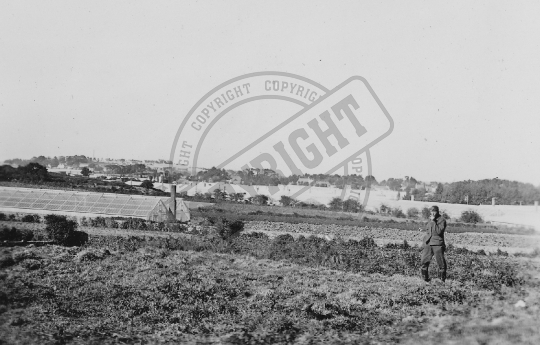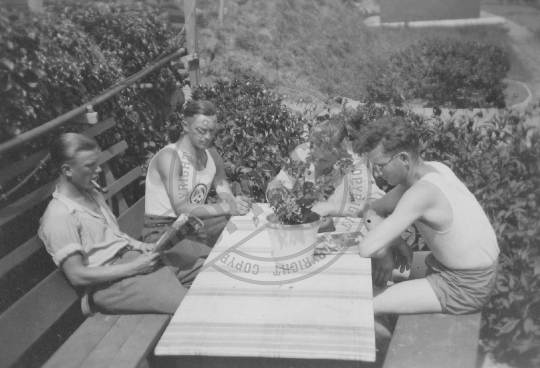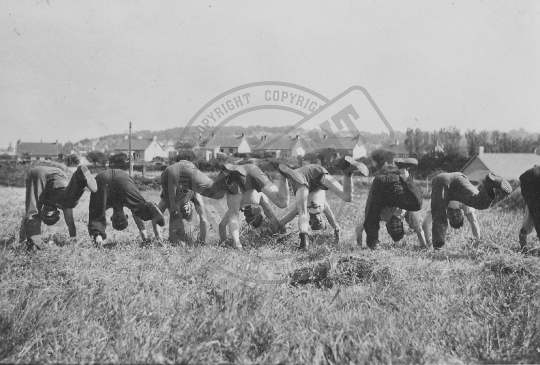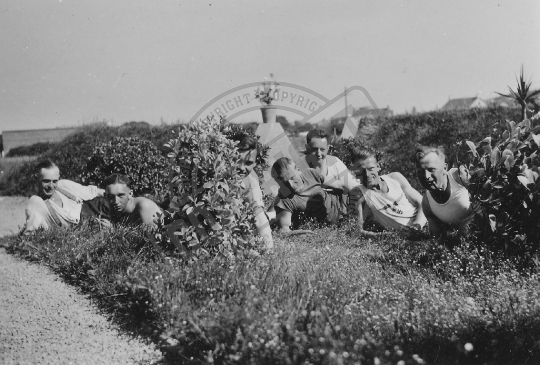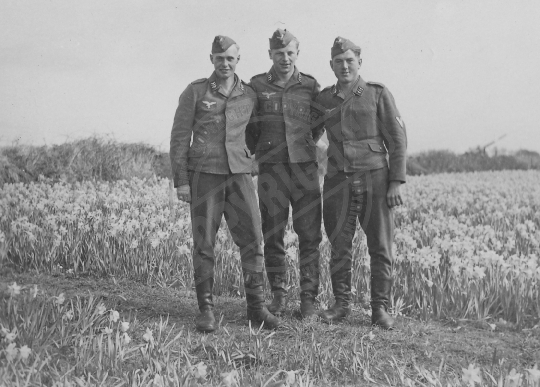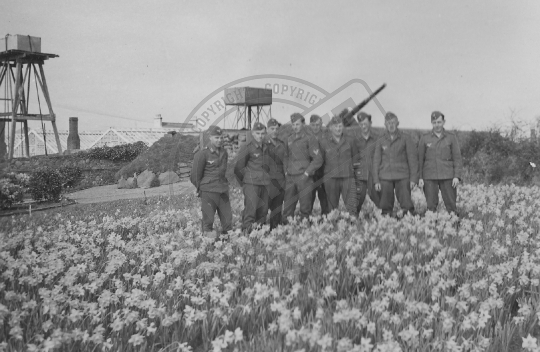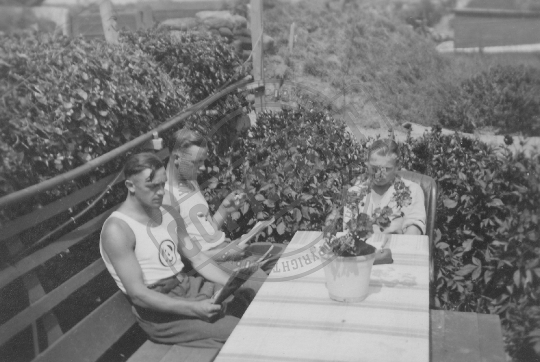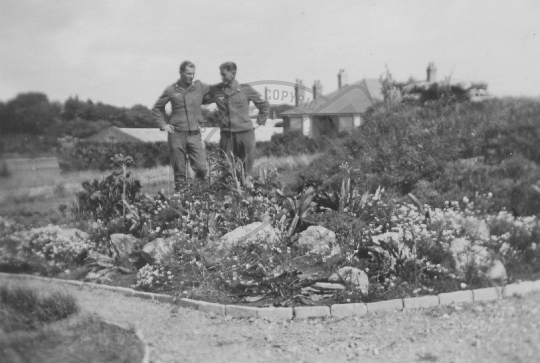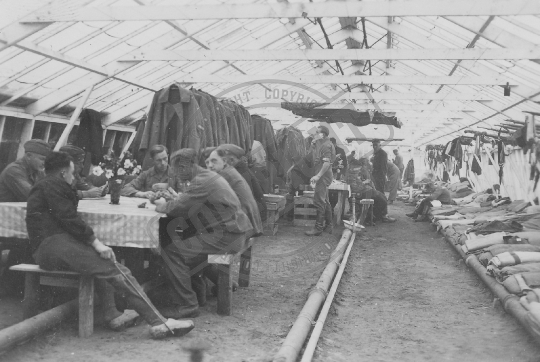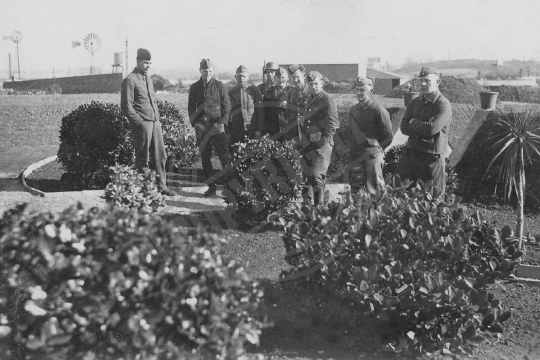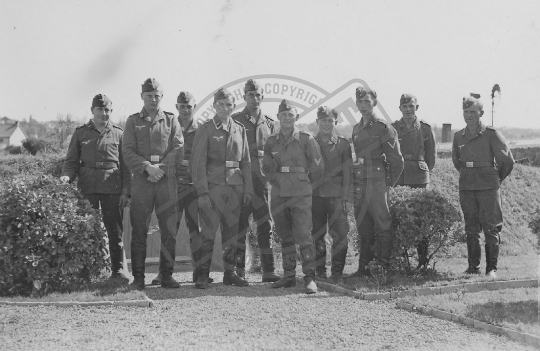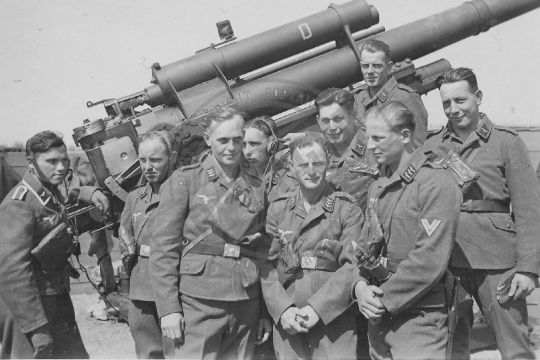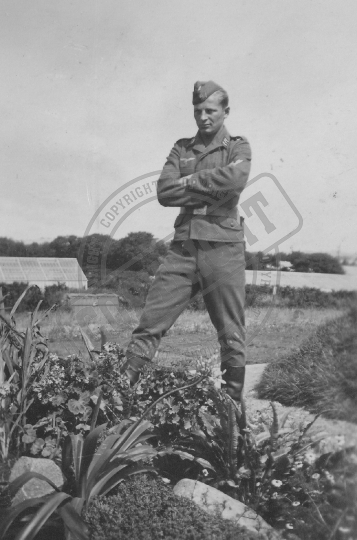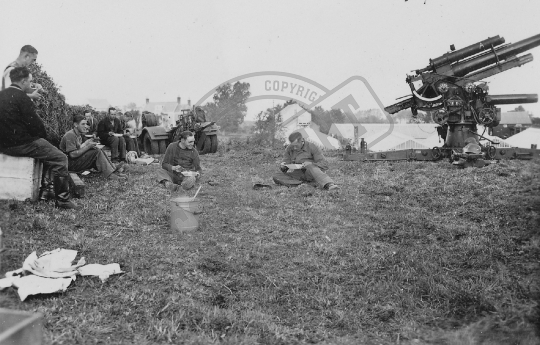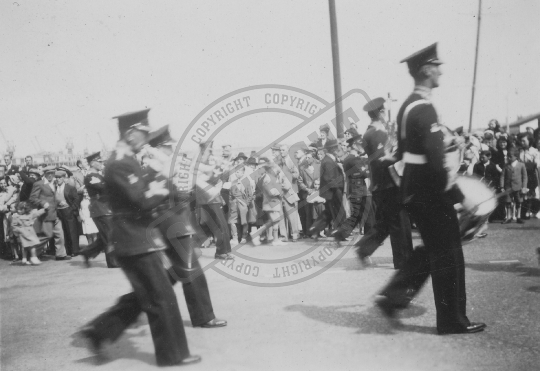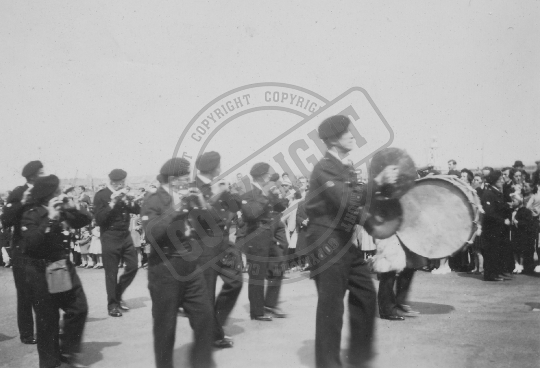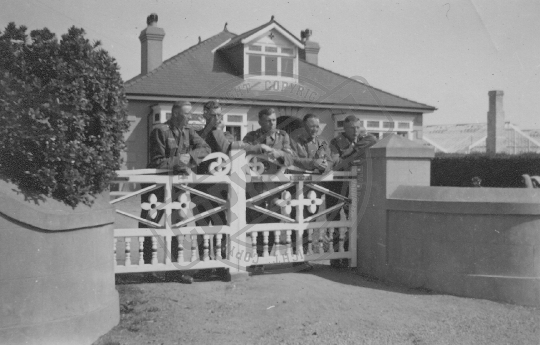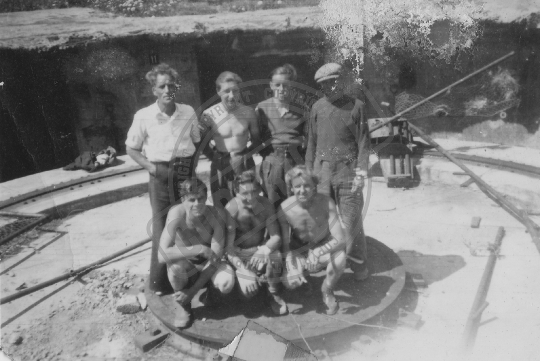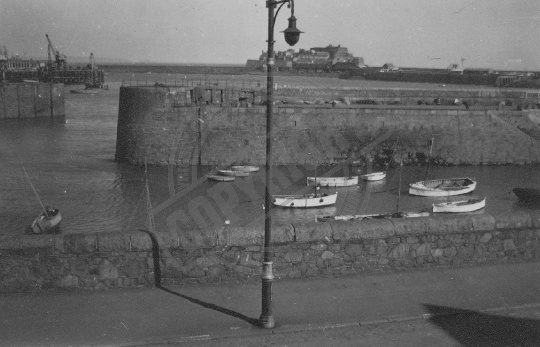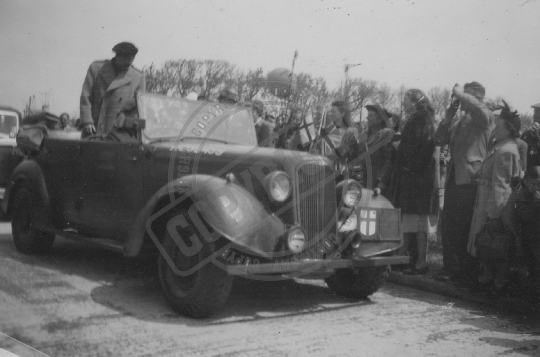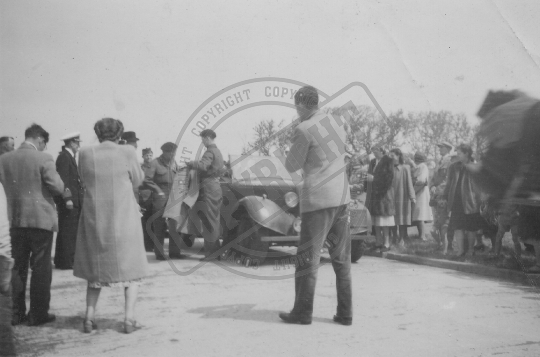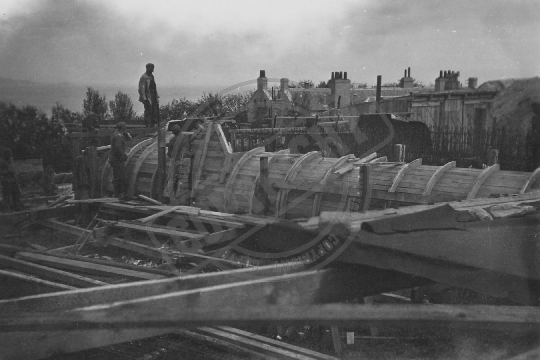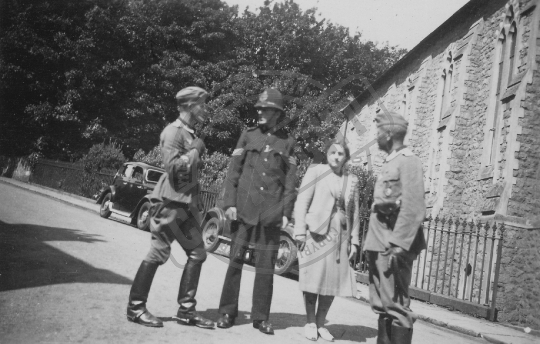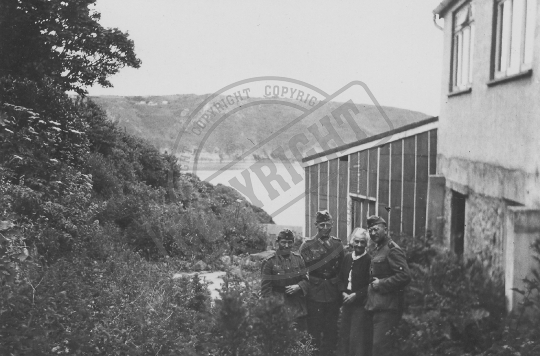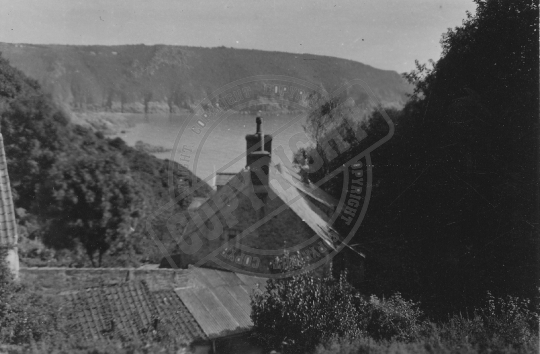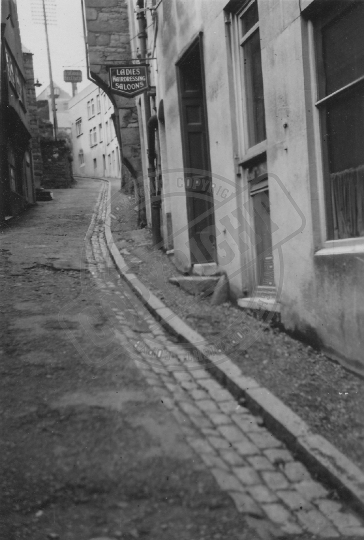Results (400)
CIMM_0072
Jersey Thursday 10th May 1945. Crowds of islanders lingered around the Weighbridge still excited from recent historic events and exchange pleasantries with the British troops sitting on the Pomme d’Or Hotel’s balcony.
CIMM_0070
Jersey Friday 11th May 1945. The Royal Court’s first sitting since the Liberation of Jersey assembled at 11 a.m. on Friday morning, 12 May 1945. In attendance were Force 135 officers including L to R; Captain L. Ogden, and Lt-Col W. Arnold, making their way through the streets of St Helier to the Court.
CIMM_0069
Jersey Thursday 10th May 1945. After the speeches the St James Boys Brigade Band, headed by Dae Donavan their drum-major, struck up a rousing march and marched out of the Royal Square followed by Lt-Col Robinson and the troops that had formed the Guard of Honour.
CIMM_0068
Jersey Thursday 10th May 1945. The Guard of Honour and the Islanders wait patiently in the Royal Square for the States Members to arrive for the Hoisting the Flag Ceremony. Lt-Col. Robinson, deep in thought, paces the pavement outside the States Buildings.
CIMM_0067
Jersey Thursday 10th May 1945. The section of crowd at the Pierson Hotel end of the Royal Square wait eagerly for the ceremony to begin.
CIMM_0066
Jersey Thursday 10th May 1945. The Guard of Honour is marched off the Weighbridge led by Lt-Col Robinson and followed closely by Captain Le Brocq.
CIMM_0064
The Guard of honour for Hoisting the Flag Ceremony on the morning of Thursday 10th May 1945 are inspected by the CSM on the Weighbridge in front of the Pomme d’Or Hotel, which will become Force 135 Tactical Headquarters.
CIMM_0063
Jersey Thursday 10th May 1945. Jerseyman Corporal Alex Mangan was kept busy signing autographs for islanders in Conway Street, St Helier.
CIMM_0061
Jersey Liberation Wednesday 9th May 1945. After unfurling the Union Jack the two RN officers chat with a Russian worker (centre), Deputy Harbourmaster Bill Furzer (left) and Harbourmaster Captain Harry Richmond (right).
CIMM_0059
Jersey Liberation Wednesday 9th May 1945. Royal Navy officers from the LCI(L) 130 and minesweepers exchange details at the top of the New North Quay, St Helier Harbour, whilst a Jersey girl listens eagerly to their conversation.
CIMM_0058
Jersey Liberation Wednesday 9th May 1945. Once moored alongside the New North Quay crew members of one of the HM Motor minesweepers relax after clearing the approaches to St Helier Harbour. This minesweeper is most probably the FY PT 542 commanded by Lieutenant Idris Edwards, RNVR.
CIMM_0054
Jersey Liberation Wednesday 9th May 1945. Officers of LCI(L) 130 with a Royal Engineer Major (third left) from the 'Omelette’ Advance Party. L to R; First Lieutenant (name unknown), RNVR; Sub.Lt. Jimmy Cooper, RNVR; and Commanding Officer, Lt Charles Sanders, RNVR.
CIMM_0051
Three British soldiers guard the main gate at Fort Regent to prevent Jersey islanders from entering. John Langlois is the small boy on someone’s shoulders waving the Red Ensign, son of Fred and Mary Langlois. Third from left is 16-year-old Dennis Perrier.
CIMM_0050
A Royal Navy rating from HMS Beagle’s launch is also given a hero’s welcome by a group of Jersey islanders outside the Harbour Office at the Weighbridge.
CIMM_0049
The launch from HMS Beagle was swamped with autograph hunters at the end of the Albert Pier, Jersey.
CIMM_0048
The launch from HMS Beagle was swamped with autograph hunters at the end of the Albert Pier, Jersey.
CIMM_0047
The launch from HMS Beagle was swamped with autograph hunters at the end of the Albert Pier, Jersey. The sailor's supply of cigarettes rapidly diminished.
CIMM_0046
The launch from HMS Beagle was swamped with autograph hunters at the end of the Albert Pier, Jersey. The sailor's supply of cigarettes rapidly diminished.
CIMM_0045
A launch from HMS Beagle with two Royal Navy officers and four ratings on board prepares to tie up at the end of the Albert Pier, Jersey.
CIMM_0043
As the craft carrying the German Island Commander and the Bailiff of Jersey reached the head of Elizabeth Castle breakwater it was passed by the launch from HMS Beagle inward bound. As the launch passed through the pierheads the crowd could see that the men on board were wearing Royal Navy uniforms, and they let out loud cheers of welcome.
CIMM_0041
Jersey Bailiff’s pinnace on its way to HMS Beagle anchored in St. Aubin’s Bay, off St. Helier. The Bailiff and the Solicitor General waved their hats repeatedly in acknowledgement as the pinnace headed out of the Harbour, whilst Generalmajor Wulf and his two staff officers stood silently in the stern of the vessel.
CIMM_0039
Jersey ex-political prisoners taken shortly after their release from the Newgate Street Prison. Left to Right: Bunny O’Neil, Mr. Rondel, Charles Gruchy, Martin Le Cornu, Hugh Le Cloche, Basil Thornton, the Dutchman Siebe Kosta, and John Bisson.
CIMM_0038
The RM Stores in King Street, St. Helier, Jersey featured the big three. Stalin, Churchill, and Roosevelt, with 'Winnie’, standing on a map of Jersey, holding up Hitler by the seat of his breeches.
SP_0047.jpg
The gun crew of Flak Batterie Kapellendorf located off Les Grandes Capelles in St Sampson. This battery of four 8.8cm Flak 18 guns which were used in an anti-aircraft role. This sequence of photographs were taken in December 1941. Note the gas holders located at Le Bouet in the background.
SP_0046.jpg
Flak Batterie Kapellendorf located off Les Grandes Capelles in St Sampson. This battery of four 8.8cm Flak 18 guns which were used in an anti-aircraft role. This sequence of photographs were taken in December 1941.
SP_0044.jpg
The gun crew of Flak Batterie Kapellendorf located off Les Grandes Capelles in St Sampson. This battery of four 8.8cm Flak 18 guns which were used in an anti-aircraft role. This sequence of photographs were taken in December 1941. Note the Luftwaffe insignia on the PT shirts.
SP_0042.jpg
The gun crew of Flak Batterie Kapellendorf located off Les Grandes Capelles in St Sampson. This battery of four 8.8cm Flak 18 guns which were used in an anti-aircraft role. This sequence of photographs were taken in December 1941.
SP_0041.jpg
The gun crew of Flak Batterie Kapellendorf located off Les Grandes Capelles in St Sampson. This battery of four 8.8cm Flak 18 guns which were used in an anti-aircraft role. This sequence of photographs were taken in December 1941.
SP_0040.jpg
The gun crew of Flak Batterie Kapellendorf located off Les Grandes Capelles in St Sampson. This battery of four 8.8cm Flak 18 guns which were used in an anti-aircraft role. This sequence of photographs were taken in December 1941.
SP_0039.jpg
The gun crew of Flak Batterie Kapellendorf located off Les Grandes Capelles in St Sampson. This battery of four 8.8cm Flak 18 guns which were used in an anti-aircraft role. This sequence of photographs were taken in December 1941.
SP_0038.jpg
The gun crew of Flak Batterie Kapellendorf located off Les Grandes Capelles in St Sampson. This battery of four 8.8cm Flak 18 guns which were used in an anti-aircraft role. This sequence of photographs were taken in December 1941. Note the Luftwaffe insignia on the PT shirts.
SP_0036.jpg
Flak Batterie Kapellendorf located off Les Grandes Capelles in St Sampson. This battery of four 8.8cm Flak 18 guns which were used in an anti-aircraft role. This sequence of photographs were taken in December 1941.
SP_0035.jpg
The gun crews of Flak Batterie Kapellendorf seen here inside a greenhouse which appears to also be the crews accommodation and rest area. Note the beds on the right and the uniforms hanging up to the left.
SP_0034.jpg
The gun crew of Flak Batterie Kapellendorf located off Les Grandes Capelles in St Sampson. This battery of four 8.8cm Flak 18 guns which were used in an anti-aircraft role. This sequence of photographs were taken in December 1941.
SP_0033.jpg
The gun crew of Flak Batterie Kapellendorf located off Les Grandes Capelles in St Sampson. This battery of four 8.8cm Flak 18 guns which were used in an anti-aircraft role. This sequence of photographs were taken in December 1941.
SP_0032.jpg
The gun crew of Flak Batterie Kapellendorf located off Les Grandes Capelles in St Sampson. This battery of four 8.8cm Flak 18 guns which were used in an anti-aircraft role. This sequence of photographs were taken in December 1941.
SP_0031.jpg
Flak Batterie Kapellendorf located off Les Grandes Capelles in St Sampson. This battery of four 8.8cm Flak 18 guns which were used in an anti-aircraft role. This sequence of photographs were taken in December 1941.
SP_0030.jpg
Flak Batterie Kapellendorf located off Les Grandes Capelles in St Sampson. This battery of four 8.8cm Flak 18 guns which were used in an anti-aircraft role. This sequence of photographs were taken in December 1941. Note the trailer for moving the gun in the background.
MT_0009
Big crowds gather on Liberation Day on May 9th 1946 to watch the procession in St Peter Port.
MT_0008
Big crowds gather on Liberation Day on May 9th 1946 to watch the procession in St Peter Port.
MT_0001
German army personnel relaxing outside a requisitioned property called The Croft in Les Canus, St Sampson formerly owned by Mrs Ruaux who was evacuated in 1940. This is a typical example of troops being billeted in local properties.
MT_0004
Victor Gontier a former internee at Laufen, seen here circa 1948 with a team from Gilroy’s which were engaged in backfilling trenches and salvaging scrap at Batterie Dollmann, Pleinmont.
MT_0003
A view of the Careening Hard at half tide, note the bomb and shrapnel damage on the raised walkway just before the end of the pier resulting from the air raid on the evening of 28 June 1940.
MT_0006
Two years after Liberation on 23rd May 1947 Guernsey had a special visit from Field Marshall Bernard Montgomery (Monty). During his visit he met with many dignitaries including those from Elizabeth College, St John Ambulance, Sea Scouts and many others. His tour was welcomed by all with the streets of Guernsey lined with locals wanting to catch a glimpse of Monty. His famous vehicle known as Old Faithful carried him around the island and included a stop at the grounds of Beau Sejour.
MT_0005
Two years after Liberation on 23rd May 1947 Guernsey had a special visit from Field Marshall Bernard Montgomery (Monty). During his visit he met with many dignitaries including those from Elizabeth College, St John Ambulance, Sea Scouts and many others. His tour was welcomed by all with the streets of Guernsey lined with locals wanting to catch a glimpse of Monty. His famous vehicle known as Old Faithful carried him around the island and included a stop at the grounds of Beau Sejour.
OA_106
Shuttering and huge quantities of steel reinforcing surround construction workers as they prepare one of the many fortifications prior to concrete being poured in the grounds of Fort George.
OA_104
A local police sergeant and civilian photographed with German soldiers outside the old Police Station located opposite St Pauls Church. The church was subsequently demolished and is now the site of the Sunken Garden.
OA_102
German soldiers with a local resident at one of the properties alongside the road leading down to Moulin Huet Bay with Jerbourg headland and the beach of Petit Port in the distance.
OA_101
Looking across the roof of the former Moulin Huet Watermill, sited alongside the road leading down to Moulin Huet Bay with Jerbourg headland and the beach of Petit Port at low water in the distance.
OA_100
A view from the foot of Bertholet Street looking up the steeply graded hill that emerges onto New Street.



